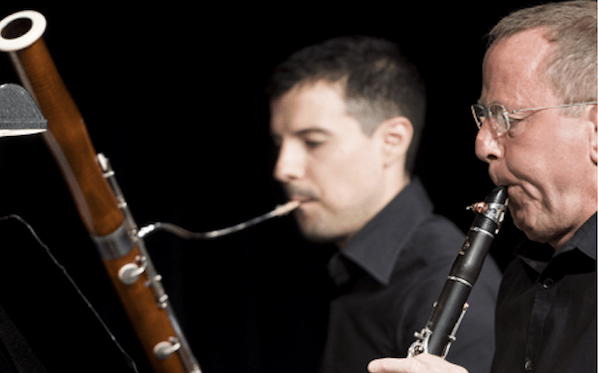When KSO principal French horn, Jeffery Whaley, began to play Samuel Barber’s 1956 “Summer Music,” Op. 31, Barber’s only music for woodwind quintet, his sound was both pure and delicate, as though he was playing on the other side of a hill, instead of sitting with his four companions: Hannah Hammel, flute; Claire Chenette, oboe; Gary Sperl, clarinet; and Aaron Apaza, bassoon. The performance was Sunday at the Sandra G. Powell Recital Hall, UT School of Music.
Now simply called the horn, it is one of the most difficult orchestral instruments to play well. Staying on pitch while playing it loudly is difficult enough. Playing it softly and dead-on is another level altogether. Whaley does it all brilliantly.
So was the playing of the other four, each with moments of playing emphasis.
“Summer Music” has the sensibility of Vivaldi’s summer section in his “Four Seasons,” without the storm and the barking dog. Yet, it is thoroughly American.
There are moments of atmospheric, bluesy references to George Gershwin’s “Summertime” and a bit of Stravinsky’s “The Rite of Spring.”
After Claire Chenette played a long, gentle breeze theme, a lot of chattering among all of the players was like a group of friends spreading out a blanket and a picnic under a tree.
Barber described the process of the piece as writing words, immersing himself in them, then letting the music flow out of them.
When I first wrote about the KSO’s chamber music performances years ago, the musicians played with orchestral section players’ mentality; always blend in, never stick out, which is the opposite of the conversational exchanges that make chamber music, such as the playing by Hammel, Chenette, Sperl, Apaza and Whaley in “Summer Music” so special.
That approach followed through when the KSO Principal String Quartet: Gordon Tsai, first violin; Edward Pulgar, second violin; Kathryn Gawne, viola; and Andy Bryenton, cello, were joined by principal flute, Hannah Hammel, for a performance of American composer Arthur Foote’s 1918 “Nocturne and Scherzo for Flute and String Quartet.”
Originally separate elements, the nocturne was created as “A Night Piece for Flute and Strings.” The scherzo part was an arrangement of the second movement of his second-string quartet.
The combined piece had none of the languid, melancholy mood of some night music. But sparkled with light, dancing flute playing that was full of charm, with the strings taking turns talking to each other and responding to the flute.
The mix of instruments changed again for Beethoven’s “Septet in E-flat Major,” Op. 20, from 1800. Violinist Gordon Tsai, violist Kathryn Bawne, cellist Andy Bryenton, hornist Jeffery Whaley and bassoonist Aaron Apaza, were joined by double bass player Steve Benne.
Beethoven came to hate the piece because its popularity overshadowed music he considered more important achievements.
But, judging by Sunday afternoon’s performance it’s easy to see why Beethoven’s adoring public loved it so much. It’s full of dancing little elements, a continual array of changing colors and textures. Each of the instruments got a chance to shine by itself and in trios and duets.
The duet between Aaron Apaza’s bassoon and Hannah Hammel’s flute was especially charming.
Of course, Beethoven gave the violin the juiciest moments, which Gordon Tsai played with both joy and precision.
This KSO performance at UT was a change from the usual venue at the Bijou Theatre. The first few performances I heard in the School of Music’s new space, the acoustics seemed a bit dry. But Sunday afternoon, the sound was warm and alive, without any sense of dullness. It felt right.

